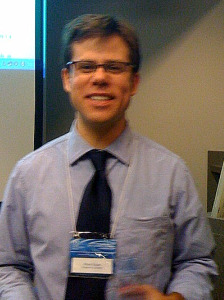The OJS Community: who is doing what with OJS: The Session Blog

Brian Edgar at PKP 2009. Photo by C. Gratham
Presenter: Brian Edgar – Stanford University. Bio
July 10, 2009, 10:00-am-10:30 pm. SFU Harbour Centre. Rm 7000
Session Overview
Mr. Edgar presented the preliminary results from a survey of over 1,000 OJS editors around the world. The goals behind the survey were to gather information about who is using the journals, where they are located, and to gain a sense of their funding models as well as what motivates them to do this work,
While the data analysis is still in the preliminary stages, Mr. Edgar presented some of the survey results and commented on a number of the findings as follows:
- South America, Europe, and North America (in descending order) accounted for 75% of the journals
- Almost half the journals were in the Social Sciences with Health Sciences and Technology and Engineering the next most common topic areas
- More than half the journals were sponsored by academic departments and another third by scholarly associations
- The rate at which the journal accepted articles was quite variable with roughly equal numbers distributed across all the acceptance rate bands
- A very high percentage of the journals used editorial and double blind review procedures
- In most of the journals, the editor is personally responsible for copy editing, layout, and proofreading
- But it is not a full-time job for the editors. In 80% of the journals, editing requires less than ten hours per week.
- Most of the journals reported small (or zero) expenses and revenues. However, a small percentage reported more than $50,000 in both. Mr. Edgar commented that these zero expense journals seem to indicate a new model for journal publishing becoming possible
- For those journals that generated revenue, it mostly came from institutional funding, followed by subscriptions, and then from advertising
- Most of the editors were motivated to do their work due to a desire to provide new knowledge and a service to the community and not for financial benefit
- While 83% of the journals qualified for inclusion in the Directory of Open Access Journals (DOAJ), only 22% actually were included
- Around 40% of responders continued to produce print journals
Questions and Audience Comments
A lively discussion ensued following Mr. Edgar’s presentation. Some of the key points are as follows:
- While the data analysis is still preliminary, they hope to have a more complete analysis by the fall of 2009.
- One audience member asked how many of the OJS journals were included in the ISI. The original survey didn’t ask about inclusion in the ISI, but they did ask about indexing.
- There was considerable discussion about why the number of OJS journals in DOAJ is small. One possible explanation is that the DOAJ has a big backlog in evaluating journals for inclusion, so it may be possible that the number of OJS journals in DOAJ will be increase as the backlog is cleared.
- There was also much discussion about those institutions reporting zero costs. There are real costs: servers, people’s time, cost of producing the knowledge, etc. But some felt that those costs are rightly viewed as a part of the operating costs of the university and it may be legitimate to not include them specifically in the journal cost. On the other hand, some people need to be able to put a time/cost as part of their justification to create an OJS journal, and they would like to see those costs broken out. An audience member pointed out that the data collected (e.g. hours per week that editors spend on the journal) can be converted to generate this data.
Related Links
2 comments
1 Recent links on Open Access « Free Our Books { 07.20.09 at 7:24 am }
[…] Results of a survey of open-access journals that use the OJS software suggest that running an OA journal can involve very low expenses, and can be a part-time job for the editor. […]
2 Recent Links on Open Access « Free Our Books { 07.27.09 at 5:39 am }
[…] make a profit. In any case, there is evidence that it need not cost much to publish a journal; many OA journals are published by universities themselves, at little or no cost. (Richard Sever argued that if universities publish OA journals, this introduces a potential […]